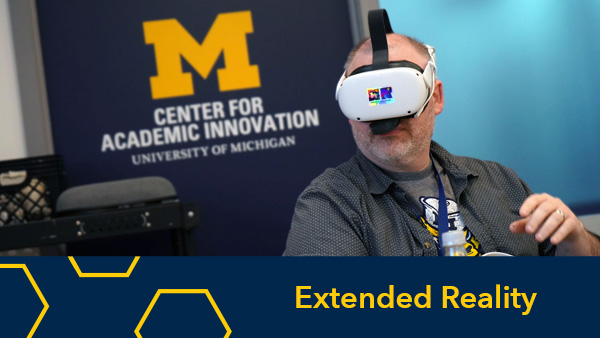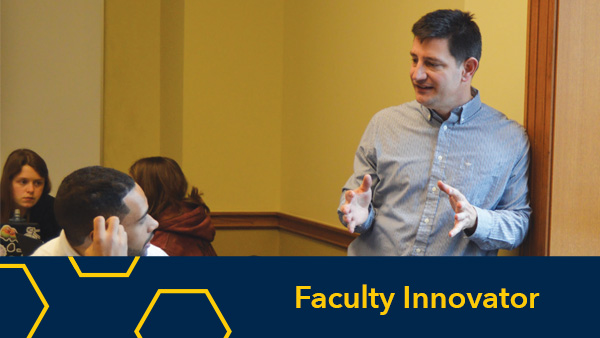This article originally appeared in Inside Higher Ed on April 15, 2020.
James DeVaney, Associate Vice Provost and Founding Executive Director, Center for Academic Innovation
@DeVaneyGoBlue
Rebecca Quintana, Learning Experience Design Lead, Center for Academic Innovation
@rebquintana
Institutions should not give up on the present in order to plan for the future, nor should they look ahead to the future before solving the problems at our doorstep. So much has changed in the last month. Yet when we zoom out from our screens and reflect back to a time before social distancing, the vision we had for the future of higher education remains unaltered. At the same time, the challenges standing in the way of realizing that vision have moved more distinctly into our field of view.
To be clear, we are not in denial about the shifts we are all experiencing nor do we underestimate the difficulty of accurately predicting the most likely future scenarios. But we take comfort from the fact that our preferred future for higher education—transformed access, inclusive learning communities, problem-based interdisciplinary education, lifelong learning, and multimodal design—remains unchanged. In fact, these goals and aspirations seem even more critical now than they did in a time before COVID-19.
Our objective in writing this post is to reflect on the circumstances that have brought us to the current moment, identify the need to move from emergency remote teaching to resilient pedagogical approaches, and share plans for a community-oriented massive open online course (MOOC) that we hope to co-design with all of you.
As we respond to the COVID-19 crisis by engaging deeply in problem solving at the University of Michigan and through conversation with peers across higher education, it is clear that pressure is mounting nearly everywhere. At once, higher education professionals are faced with real issues in the form of maintaining short term continuity and also rising uncertainty about longer term sustainability. All too often in the last few weeks, we’ve heard people weigh short term needs against long term aspirations. We don’t believe this is a choice between two options. We need to climb out of this crisis while building capabilities to better prepare ourselves for future disruption.
March was the month of whack-a-mole. You may know it as emergency remote teaching. We witnessed heroic efforts across the higher education landscape as learning experience designers, instructional technologists, behavioral scientists and many others lept into action. These professionals worked to rapidly transfer some portion of a course to an online environment to ensure continuity of instruction during unpredictable emergent situations that curtailed one’s ability to teach on-campus. This occurred many times simultaneously across varied contexts – from intimate graduate seminars to large undergraduate foundational courses.
Adopting emergency remote teaching was an essential step on the road to future preparedness. Universities were underprepared for an overnight shift to high quality online teaching and learning. The moment called for rapid approaches that would ensure continuity of instruction and student wellness. But emergency remote teaching alone will not carry our institutions out of crisis. It took a moment like the one we are in to recognize the distance we need to travel in order to more effectively navigate future disruptions. Fortunately, while the journey is not brief, the milestones are coming into view.
We must travel purposefully through a period of emergency remote teaching, to enhanced remote teaching, and ultimately to hybrid resilient teaching. At each stage we need to lead with institutional values while distinguishing one stage from another, adopting clear language and objectives. Importantly, we cannot assume that faculty will be ready to move forward from one stage to another in lock-step. Different levels of familiarity and comfort with online teaching and technology call for a range of individualized educational development opportunities, communities of practice, and other forms of support. We stabilized our campuses over the last month. As we look ahead to spring, summer and fall, we can begin to transition from emergency remote teaching strategies and begin integrating more effective online instructional techniques.
At Michigan, we have been actively creating resources and course design workshops to help through this moment. We will create other learning experiences, resources and communities of practice to help address the essential needs of our faculty as we embrace the institutional change we knew was required long before COVID-19, but now on a trajectory that defies our prior logic about effective faculty development and institutional change.
As we build scaffolding, resources, and moral support for a large number of faculty with the immediate goal of climbing out of the current crisis, we must not lose sight of the north star that guides our work. We believe we can and must continue to shape the future while we navigate the current crisis.
A New MOOC for Cultivating Resilient Teaching Approaches
One way we plan to do this is by developing a massive open online course on resilient teaching, one that offers inspiration and practical guidance on cultivating resilient pedagogical approaches and builds a new community for practitioners and scholars. We will engage in a rapid design process over the coming weeks and launch this new course in May.
In the rest of this post we share why we think this course is needed in this particular moment, discuss how we plan to move forward with course design, and describe how we seek to engage a community of our peers in the design process. Over the last month we’ve been constantly reminded through social media and other networks that we are part of an amazing community of practitioners and scholars who engage deeply in problem solving. Building on this collaborative ethos, we invite you to respond to a few questions we will pose for all of you to consider as we design this new course to make sure it points us all in the direction of hybrid resilient teaching for a new instructional age.
Motivation for Developing the Course
With the recent turn to emergency remote teaching, higher education faculty, lecturers, and instructors have had to quickly transfer their residential courses to a digital format. While these circumstances were suboptimal because they necessitated an abrupt transition, the recent experience of many instructors sheds light on resilient approaches to teaching.
As we gain inspiration from this large-scale transfer of courses to an online format, we seek to move towards supporting more deliberate and thoughtful transformation of course designs that are responsive to changing environmental contexts. Whether instructors will experience hybrid, fully online, or face to face learning environments, we anticipate that this new open online course will offer participants tools and frameworks for cultivating resilient pedagogical approaches.
By focusing on how teaching plans can be designed to be resilient to change, instructors will be better prepared to adapt their course designs when learning environment conditions change.
Evolving Plans for Course Design
Our working title for our new open online course is Resilient Teaching Through Times of Crisis and Change. Our course is intended to serve higher education faculty, lecturers, and graduate student instructors who anticipate that their teaching environments will continue to be impacted by the current COVID-19 crisis.
By applying insight from developmental psychology, curriculum studies, business management strategies, and crisis management studies, this course aims to prepare and equip educators and their students to thrive when changes emerge in their educational environments. Course goals include offering a working definition of resilient teaching for higher education contexts and to describe attributes of approaches to resilient design.
Our course offering will help participants identify strategies for cultivating resilient teaching approaches, draw inspiration from examples that highlight resilient teaching, leverage technology and tools to pivot towards online and hybrid instruction if necessary, and develop instructional contingency plans to maintain curricular coherence despite contextual change.
Moreover, we hope that this course will become a forum that surfaces examples of resilient pedagogies in action. We hope to allow participants to discover, share and learn from examples around them.
Call for Collaboration
We conclude by inviting you to contribute to the design of this open online course by responding to the following questions. Our aim is to provide our community of practitioners and scholars with the opportunity to influence what this course will become, so that it can become an available and widely used resource for many.
- What else should we consider in creating this course?
- Are there examples of resilient teaching that we should feature?
- What are you doing at your institution to move from emergency remote teaching to resilient teaching?
Please share your ideas through this Google form. We look forward to hearing from you!


